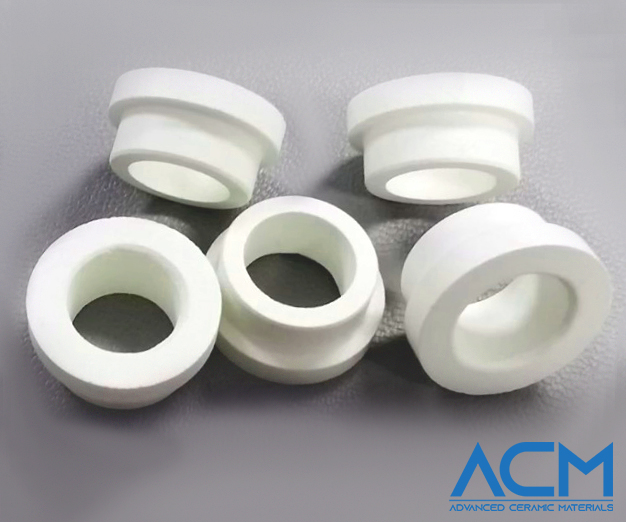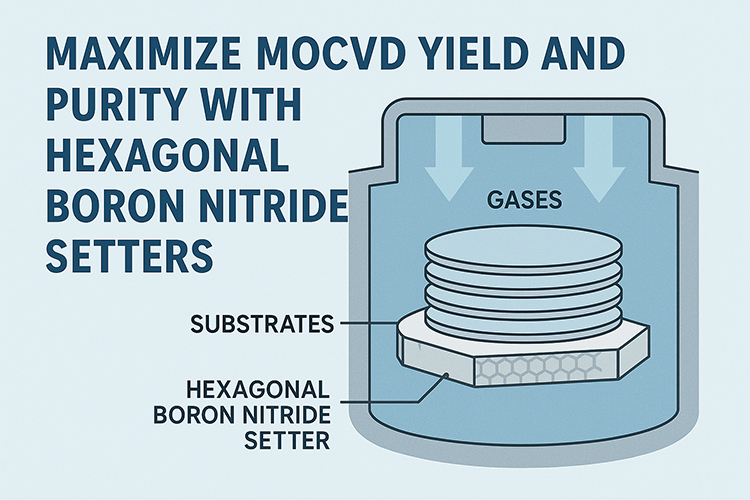Comparing Beryllium Oxide vs. Aluminum Nitride in Thermal Conductivity and Beyond
Introduction
In advanced ceramics, materials such as Beryllium Oxide (BeO) and Aluminum Nitride (AlN) are highly prized for their exceptional thermal conductivity and robust physical properties. These materials are crucial in sectors where superior heat dissipation is essential, such as in electronics, aerospace, and automotive industries. Their ability to maintain integrity and performance at high temperatures makes them indispensable in applications ranging from heat sinks and electronic substrates to insulators in high-power devices.
This article will delve into a detailed comparison of Beryllium Oxide and Aluminum Nitride, focusing on their thermal conductivity and extending the analysis to other vital characteristics. By examining these materials side-by-side, we aim to highlight their specific advantages and potential applications, providing a clear perspective on their suitability for various technological and industrial uses. This comparative study will not only shed light on their strengths but also guide material selection for engineers and designers looking to optimize their high-temperature operations.
Properties Overview
Beryllium Oxide (BeO):
- Physical Properties: BeO is a white crystalline oxide that exhibits exceptional hardness and strength. It has a high melting point of about 2570°C, which supports its use in high-temperature environments.
- Chemical Properties: Chemically, BeO is inert to most acids and alkalis at normal temperatures, offering excellent corrosion resistance. However, it is soluble in more concentrated acids, which may limit its use in certain environments.
- Thermal Properties: One of the standout features of BeO is its thermal conductivity, which can be as high as 330 W/mK, making it one of the best heat-conducting materials among ceramics.
Read more: An Introduction to Beryllium Oxide Ceramics
Aluminum Nitride (AlN):
- Physical Properties: AlN is known for its high thermal conductivity combined with excellent electrical insulation properties. It has a density of about 3.26 g/cm³ and exhibits good mechanical strength.
- Chemical Properties: AlN is resistant to oxidation and attacks by most molten metals, making it suitable for use in harsh environments. It is also stable in inert and reducing atmospheres up to 2200°C.
- Thermal Properties: Aluminum Nitride has a thermal conductivity value ranging from 170 to 200 W/mK, which is superior among most other ceramic materials but slightly lower than BeO.
Read more: What is Aluminum Nitride Ceramic?
The following table compares the key properties of Beryllium Oxide and Aluminum Nitride:
| Property | Beryllium Oxide (BeO) | Aluminum Nitride (AlN) |
|---|---|---|
| Melting Point | 2570°C | 2200°C |
| Density | 2.85 g/cm³ | 3.26 g/cm³ |
| Thermal Conductivity | 330 W/mK | 170-200 W/mK |
| Chemical Stability | Resistant to most acids and bases | Resistant to oxidation and molten metals |
Thermal Conductivity Analysis
Thermal conductivity is a pivotal factor in materials used for heat dissipation in electronic and industrial applications. Both Beryllium Oxide (BeO) and Aluminum Nitride (AlN) offer high thermal conductivity, but their specific characteristics suit different technological needs.
Beryllium Oxide (BeO): BeO's thermal conductivity is remarkably high, reaching up to 330 W/mK, making it one of the most effective ceramic materials for heat management. This property is particularly beneficial in applications such as:
- Electronic substrates and insulators: Where rapid heat dissipation is crucial to maintain the performance and longevity of electronic components.
- High-power laser tubes and microwave applications: Where managing high temperatures efficiently is vital to ensure operational stability and efficiency.
The exceptional thermal conductivity of BeO is due to its crystal structure, which facilitates efficient heat transfer. However, the use of BeO is often limited by its toxicity, requiring careful handling and specific safety measures during manufacturing and recycling.
Aluminum Nitride (AlN): Although AlN has a lower thermal conductivity than BeO, ranging from 170 to 200 W/mK, it is still highly effective and preferable in scenarios where non-toxicity is crucial. AlN is extensively used in:
- LEDs and semiconductor devices: Where it serves as a heat sink that effectively draws heat away from active areas, thereby increasing device reliability and performance.
- Power electronic applications: It provides excellent thermal management solutions without the risk associated with BeO.
AlN also combines its good thermal properties with great electrical insulation capabilities, making it particularly valuable in electronic applications where both high thermal conductivity and electrical resistance are required.
Comparison in Applications:
- BeO is preferred in more niche, high-temperature applications where its superior thermal conductivity can be leveraged despite the toxicity risks.
- AlN is favored in consumer electronics and safer industrial environments, where handling and environmental health and safety are of paramount concern.
Other Critical Characteristics
In addition to thermal conductivity, several other properties are crucial when choosing between Beryllium Oxide (BeO) and Aluminum Nitride (AlN). These characteristics include electrical insulation, mechanical strength, and thermal expansion, which play significant roles in determining their practical applications.
Electrical Insulation:
- BeO: Offers excellent electrical insulation properties, with a dielectric strength of approximately 10-16 kV/mm. This makes it suitable for use in high-voltage applications and electronic devices where insulation and heat dissipation are simultaneously required.
- AlN: Also provides very good electrical insulation capabilities, comparable to BeO, which is essential for its use in electronic substrates and circuit carriers in power electronics.
Mechanical Strength:
- BeO: Exhibits high mechanical strength and hardness, which is beneficial in environments where structural integrity under high stress or temperature is critical. Its robustness makes it ideal for military and aerospace applications where reliability under extreme conditions is mandatory.
- AlN: Although slightly less hard than BeO, AlN still provides sufficient mechanical strength that supports its use in mechanically demanding applications. Its toughness is particularly valued in the automotive and aerospace industries for sensors and electronic components.
Thermal Expansion:
- BeO: Has a relatively low coefficient of thermal expansion, which closely matches that of silicon. This compatibility is crucial in semiconductor applications to avoid stress and potential damage caused by thermal mismatch.
- AlN: Similar to BeO, AlN has a low coefficient of thermal expansion, which helps in minimizing stress and maintaining structural integrity in fluctuating temperatures, especially in composite materials.
Chemical Stability:
- BeO: Chemically stable and resistant to a vast majority of acids and bases at high temperatures, which ensures longevity and reliability in harsh chemical environments.
- AlN: Shows excellent resistance to oxidation and strong acids, making it suitable for applications involving harsh environmental conditions.
This table focuses on the direct comparison of each material’s capabilities, making it easier to assess their applications and suitability for specific environments.
| Property | Beryllium Oxide (BeO) | Aluminum Nitride (AlN) |
|---|---|---|
| Electrical Insulation | Excellent; suitable for high-voltage and electronic devices. | Very good; essential for electronic substrates in power electronics. |
| Mechanical Strength | High strength and hardness; ideal for aerospace and military applications. | Sufficient for automotive and aerospace applications; slightly less hard than BeO. |
| Thermal Expansion | Low; matches silicon, minimizing semiconductor stress. | Similar to BeO; maintains integrity under temperature fluctuations. |
| Chemical Stability | Resistant to most acids/bases; suitable for harsh chemical environments. | Excellent resistance to oxidation and acids; suitable for harsh conditions. |
Industrial Applications
The unique properties of Beryllium Oxide (BeO) and Aluminum Nitride (AlN) have led to their extensive use in a variety of industrial applications. Understanding where and how these materials are employed can provide insights into their practical utility and the factors driving their selection.

Beryllium Oxide (BeO):
- Electronics: Due to its excellent thermal conductivity and electrical insulation, BeO is used in electronic substrates and chip carriers, especially in applications requiring rapid heat dissipation.
- Aerospace and Defense: Its high thermal stability and mechanical strength make it ideal for military and aerospace applications, including heat sinks and electronic packaging in satellites and aircraft where reliability under extreme conditions is crucial.
- Nuclear Applications: BeO is employed in nuclear reactors as a neutron moderator and reflector due to its low neutron absorption cross-section and good thermal properties.
Aluminum Nitride (AlN):
- Semiconductors: AlN's combination of high thermal conductivity and electrical insulation makes it perfect for semiconductor applications, particularly in power electronics and optoelectronics where it serves as a heat sink that helps maintain device integrity.
- LEDs: The material is commonly used in the substrate of LEDs due to its ability to draw heat away from the diodes, which increases the efficiency and lifespan of the lights.
- Automotive: AlN is used in sensors and electronic components that must withstand high temperatures and harsh environments typically found in automotive applications.
Comparison of Applications:
- High-Temperature Environments: BeO's superior thermal conductivity and mechanical properties make it suitable for high-temperature applications in aerospace and defense, whereas AlN, with slightly lower thermal conductivity but better safety profile, is preferred in consumer electronics and automotive industries.
- Safety and Environmental Concerns: Due to the toxic nature of BeO, its use is restricted and handled with extreme care, primarily in controlled industrial environments. AlN, being non-toxic, is favored in applications where health and environmental safety are a priority.
Conclusion
The exploration of Beryllium Oxide (BeO) and Aluminum Nitride (AlN) throughout this article underscores the critical importance of these materials in a variety of high-performance applications. Each material's unique combination of thermal conductivity, electrical insulation, and mechanical strength makes it indispensable in specific sectors, from electronics and aerospace to automotive and defense.
Collaboration between researchers, industry stakeholders, and manufacturers will be crucial in overcoming existing challenges and unlocking the full potential of these advanced materials. As part of this collaborative effort, Advanced Ceramic Materials (ACM) continues to be a key player, offering expertise and high-quality ceramic materials to support cutting-edge developments in the field of advanced ceramics.
{{item.content}}
LEVE A REPLY
{{item.children[0].content}}
{{item.content}}
LEAVE A REPLY
SUBSCRIBE OUR NEWSLETTER
- Boron Nitride in Cosmetics: Enhancing Performance and Sensory Appeal
- Maximize MOCVD Yield and Purity with Hexagonal Boron Nitride Setters
- What Are the Advantages and Uses of Boron Nitride Ceramic Sheet?
- The Compression Annealing Advantage for Pyrolytic Boron Nitride
- Beyond Insulation: The Surprising Spectrum of Ceramic Thermal Conductivity













